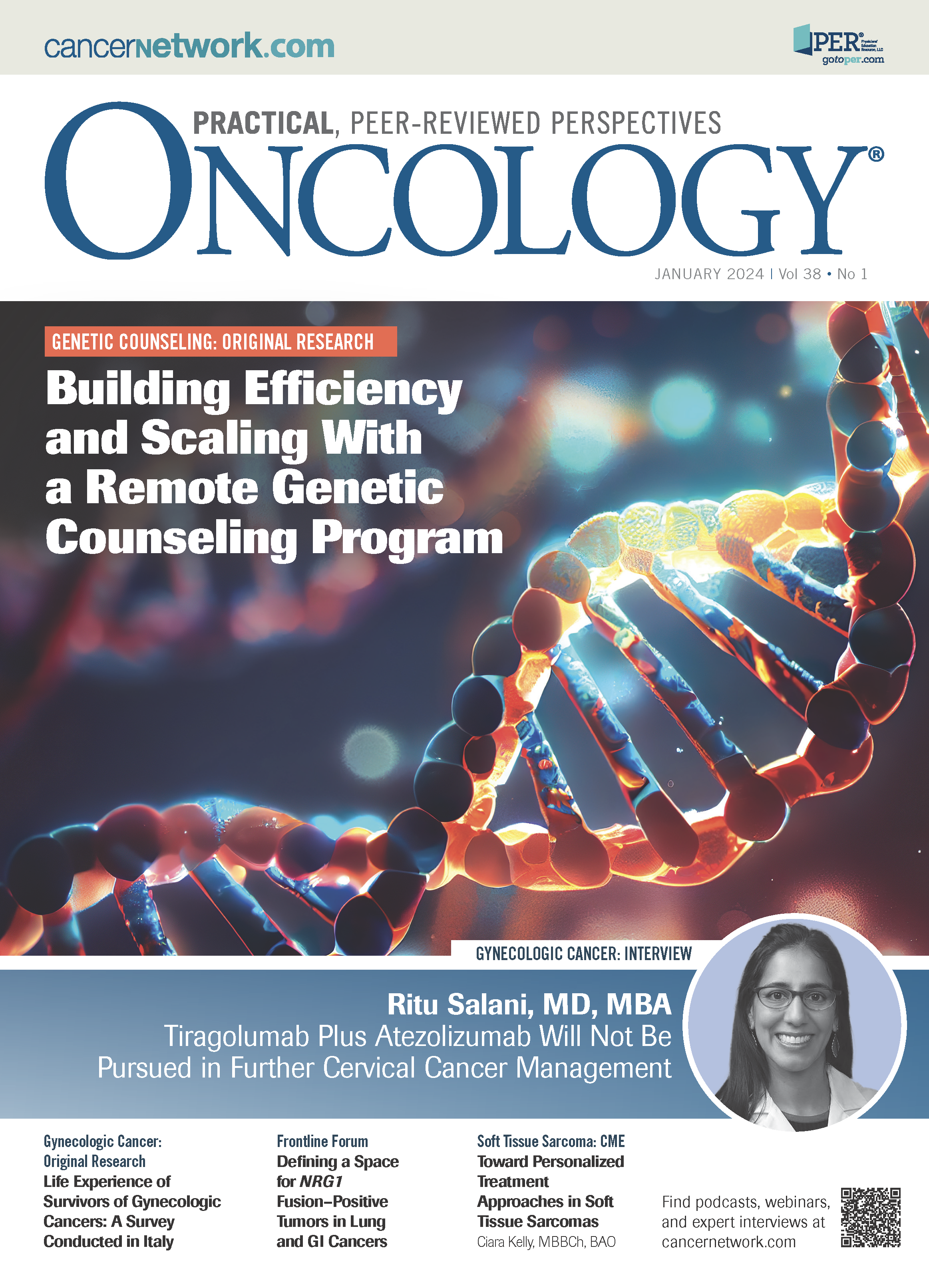Tiragolumab Plus Atezolizumab Will Not Be Pursued in Further Cervical Cancer Management
Ritu Salani, MD, MBA, discussed the results from the phase 2 SKYSCRAPER-4 trial, which determined tiragolumab plus atezolizumab should not be used to treat PD-L1–positive recurrent cervical cancer.
Ritu Salani, MD, MBA
Gynecologic Oncology Fellowship Director UCLA Health
Los Angeles, CA

Ritu Salani, MD, MBA, highlighted the results from the phase 2 SKYSCRAPER-04 trial (NCT04300647), whichcombined tiragolumab with atezolizumab (Tecentriq) for patients with PD-L1–positive recurrent cervical cancer.1
Across the total patient population, the primary end point of objective response rate (ORR) was 19% in patients who received tiragolumab plus atezolizumab compared with 15.6% in those treated with atezolizumab alone. Among 105 patients with PD-L1–high tumors, the ORR was 25% and 20.7% among those who received combination therapy and monotherapy, respectively. Of 66 patients with PD-L1–low tumors, a response was observed in 10% of patients who received combination therapy and 6.3% of those who received monotherapy. However, although a response was seen, it did not match statistical significance for historical reference. Salani, gynecologic oncology fellowship director at UCLA Health in Los Angeles, California, and gynecologic editorial board member for ONCOLOGY, touched on why future research efforts will not be pursued with this combination and upcoming treatment options for patients with cervical cancer.
Q: What was the rationale behind the phase 2 SKYSCRAPER-04 study?
Salani : In recurrent cervical cancer, we’ve seen that the addition of checkpoint inhibitors has benefited patients with ORR and duration of responses. Unlike what we’ve seen with chemotherapy, even though [checkpoint inhibitors] leave a lot to be desired, this was a huge advantage for these patients. The rationale behind the phase 2 SKYSCRAPER-04 trial was to see whether we could continue to leverage the immune system by adding a TIGIT inhibitor to a checkpoint inhibitor to see whether we could avoid immune system exhaustion and continue to capitalize on the benefit of the immunotherapy.
Q: The trial showed an improvement in the ORR, but the impact of the ORR did not reach statistical significance based on historical reference. Can you address these results?
Salani: There are 2 points to this study. One, this was the first study using a single-agent checkpoint inhibitor in this controlled fashion, so in a phase 2 study. We were able to show that a PD-L1 inhibitor was comparable to what we see historically with PD-1 inhibitors. That was an important takeaway. Unfortunately, the addition of the TIGIT inhibitor wasn’t able to overcome that immune exhaustion. Although we did see numerical improvement, we weren’t able to show that this was statistically significant. The addition of a TIGIT inhibitor to a checkpoint inhibitor, in this case atezolizumab, didn’t provide the improvement that we were hoping to see.
Q: Are there any adverse effects (AEs) clinicians should be aware of based on the study?
Salani: One important message is that the checkpoint inhibitor therapy was safely administered. There were no new safety signals. This has been used across other disease sites [as well]. This [study] continues to add to that experience. Even with the addition of the TIGIT inhibitor, [there was a] minimal increase in AEs. They were slightly higher, but no grade 5 AEs and very few grade 3 or 4 AEs [were observed]. It is a safe combination; it just wasn’t as effective as we were hoping.
Q: Are there any next steps in researching the tiragolumab/atezolizumab combination in this patient population?
Salani: In this patient population, the addition of a TIGIT [inhibitor] and a PD-L1 or PD-1 inhibitor probably does not have any path forward in that combination alone. [In future studies, clinicians should] consider adding it to bevacizumab or other agents that might have some viability, but this is probably the end of a TIGIT PD-1/PD-L1 combination.
Q: Are you currently working on any research you’d like to highlight?
Salani: Continuing to exploit the immune system is important in cervical cancer. This is a patient population who has not gotten a lot of attention. With the advent of immunotherapy in the setting, we’ve found some avenues of treatment. One thing I’m excited about that I’m working on is this [phase 2 VB-C-02 trial] looking at the human papillomavirus type 16 [HPV-16] target, and it’s a vaccine targeting HPV-16 in combination with immunotherapy in patients who have been previously exposed to immunotherapy.2 This is not an immunotherapy-naive population; it’s one who’s seen it. This is a population [with] high-risk [disease], but for HPV-16 cervical cancers, we can see whether we can capitalize on targeting the HPV-16, complementing it with immunotherapy, and continuing to see whether we can get that benefit from the immune system. It makes sense because cervical cancer is infection related, so using the immune system is a logical target. We just have to find that right combination. Knowing that we have some benefit with immunotherapy [and are] seeing it move to earlier settings [such as] the frontline setting, there may be some potential for it to be moved even with chemoradiation. Understanding the sequencing of these therapies but also understanding that immune therapy may play a role even after a prior checkpoint inhibitor therapy and continuing to explore those avenues is exciting. That’s what I’m most excited about.
Q: Is there anything else you’d like to add?
Salani: Cervical cancer is an area that’s being studied aggressively right now. We have approval with tisotumab vedotin-tftv [Tivdak], which [had an] accelerated approval.3 We just saw the confirmatory phase 3 data that were positive. That will hopefully be another avenue of treatment for our patients. Looking at other targets, there were some compelling data. Although it’s not the most common biomarker, HER2 positivity may be another avenue for patients with cervical cancer, particularly adenocarcinoma. Then there’s some interest in looking at TROP2 inhibitors and cervical cancer. We cannot rest on the gains we have had. They’re modest, and we can do better. This is an exciting area of study. Encouraging patients to go on trials, making sure patients get access to these trials, and giving these patients access to the best therapies are going to be critical areas of study.
REFERENCES
- Salani R, Monk BJ, Kim Y, et al. Efficacy and safety results from SKYSCRAPER-04: an open-label randomized phase 2 trial of tiragolumab plus atezolizumab for PD-L1-positive recurrent cervical cancer. Abstract presented at: International Gynecologic Cancer Society 2023 Annual Global Meeting; November 5-7, 2023; Seoul, South Korea. Abstract PO002/156.
- Nykode Therapeutics announces positive final results from its phase 2 trial of VB10.16 in combination with PD-L1 inhibitor atezolizumab in advanced cervical cancer. News release. Nykode Therapeutics. April 18, 2023. Accessed April 20, 2023. https://bit.ly/3TxBM2z
- Seagen and Genmab announce FDA accelerated approval for TIVDAK (tisotumab vedotin-tftv) in previously treated recurrent or metastatic cervical cancer. News release. Seagen. September 20, 2021. Accessed December 1, 2023. https://tinyurl.com/mufmjx59

Newsletter
Stay up to date on recent advances in the multidisciplinary approach to cancer.